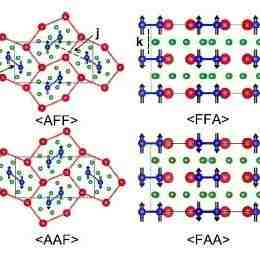Npj Comput. Mater.:新材料预测—三元硼化物中的范霍夫奇点体系

海归学者发起的公益学术平台
分享信息,整合资源
交流学术,偶尔风月
Fig. 1 Crystal structure of (a-c) α-ATB4 and (d-f) β-ATB4.
来自厦门大学的孙阳副教授与美国爱荷华州立大学的Kai-Ming Ho, Vladimir Antropov和Kirill Kovnir教授,通过高通量晶体结构搜索,发现了一类在三元ATB4型硼化物中具有结构稳定性和范霍夫奇点的材料。
Fig. 2 Stability of non-RE ATB4 phases (spin-polarized calculations).
由于这类材料的特殊原子结构,3d过渡金属原子形成了类似分子状态的二聚体结构,导致电子结构中出现范霍夫奇点并保持材料的稳定性。这些范霍夫奇点在3d带的电子填充接近半满时较强,而在3d带的空缺或满占附近则较弱,这种近似刚性的能带结构为不同类型量子态的出现和涨落创造了有利条件。在含有3d族中部原子的材料中,范霍夫奇点导致了磁性的不稳定性,使材料产生了多种磁性基态,并呈现出弱金属或半导体性质,类似于一个非平凡的自旋玻璃体系,其中一些系统还出现了罕见的Slater式金属-绝缘体转变。
Fig. 3 The energy difference and magnetic moment for different magnetic states. a
通过固态合成方法,作者探索了制备这类化合物的可能性,并意外地合成了新型的镁铁硼三元化合物。尽管目前实验制备ATB4仍然具有挑战性,作者们提出了更多样的合成思路,有待进一步研究。ATB4系列材料的发现将为研究范霍夫奇点系统以及调控新的量子态提供机会。作者所使用的寻找具有范霍夫奇点材料的理论计算方法可以进一步推广至其他体系,从而加速新型量子材料的发现。
Fig. 4 Experimental attempts to synthesize 114 phases.
该文近期发表于npj Computational Materials 9:204(2023),英文标题与摘要如下,点击左下角“阅读原文”可以自由获取论文PDF。
Prediction of Van Hove singularity systems in ternary borides
Yang Sun, Zhen Zhang, Andrew P. Porter, Kirill Kovnir, Kai-Ming Ho & Vladimir Antropov
A computational search for stable structures among both α and β phases of ternary ATB4 borides (A = Mg, Ca, Sr, Ba, Al, Ga, and Zn, T is 3d or 4d transition elements) has been performed. We found that α-ATB4 compounds with A = Mg, Ca, Al, and T = V, Cr, Mn, Fe, Ni, and Co form a family of structurally stable or almost stable materials. These systems are metallic in non-magnetic states and characterized by the formation of the localized molecular-like state of 3d transition metal atom dimers, which leads to the appearance of numerous Van Hove singularities in the electronic spectrum. The closeness of such singularities to the Fermi level can be easily tuned by electron doping. For the atoms in the middle of the 3d row (Cr, Mn, and Fe), these singularities led to magnetic instabilities and magnetic ground states with a weakly metallic or semiconducting nature. Such states appear as non-trivial coexistence of the different spin ladders formed by magnetic dimers of 3d elements. These magnetic states can be characterized as an analog of the spin glass state. Experimental attempts to produce MgFeB4 and associated challenges are discussed, and promising directions for further synthetic studies are formulated.
扩展阅读
媒体转载联系授权请看下方
关键词
Npj Comput.Mater
金属
性质
电子
结构
最新评论
推荐文章
作者最新文章
你可能感兴趣的文章
Copyright Disclaimer: The copyright of contents (including texts, images, videos and audios) posted above belong to the User who shared or the third-party website which the User shared from. If you found your copyright have been infringed, please send a DMCA takedown notice to [email protected]. For more detail of the source, please click on the button "Read Original Post" below. For other communications, please send to [email protected].
版权声明:以上内容为用户推荐收藏至CareerEngine平台,其内容(含文字、图片、视频、音频等)及知识版权均属用户或用户转发自的第三方网站,如涉嫌侵权,请通知[email protected]进行信息删除。如需查看信息来源,请点击“查看原文”。如需洽谈其它事宜,请联系[email protected]。
版权声明:以上内容为用户推荐收藏至CareerEngine平台,其内容(含文字、图片、视频、音频等)及知识版权均属用户或用户转发自的第三方网站,如涉嫌侵权,请通知[email protected]进行信息删除。如需查看信息来源,请点击“查看原文”。如需洽谈其它事宜,请联系[email protected]。